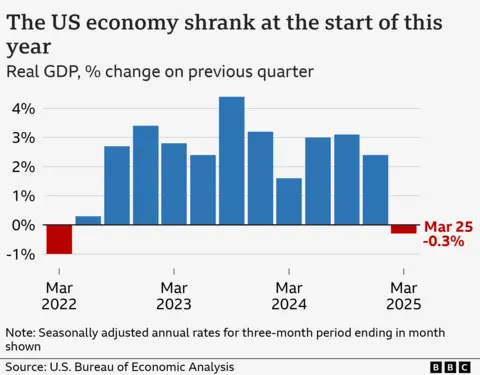Business reporter, BBC News
 Getty Images
Getty ImagesThe US economy shrank in the first three months of the year due a drop in government spending and a surge in imports as firms raced to get goods into the country ahead of tariffs.
The economy contracted at an annual rate of 0.3%, a sharp downturn after growth of 2.4% in the previous quarter, the Commerce Department said.
The report is the most comprehensive reading of how the world’s largest economy is holding up as the introduction of import taxes by President Donald Trump, which has scrambled global trade and created major uncertainty.
But analysts said it would take more time to understand the impact of those changes.
While imports count against growth in calculations of gross domestic product (GDP), the surge is expected to be reversed in the months ahead. Those swings do not necessarily indicate an economy performing poorly.
The data showed business investment increased unexpectedly, while consumer spending – the primary driver of the US economy – also expanded, though at a slower pace than in 2024.
Final sales to private domestic purchases – a closely watched indicator of overall demand – grew a solid 3%, little changed from the previous quarter.
“Overall, not as bad as feared,” said Paul Ashworth, chief North America economist at Capital Economics.
Since re-entering the White House in January, Trump has taken the business world by storm, announcing a series of new trade tariffs that he says will raise money for the government and help boost US manufacturing.
While he has watered down some of the policies in face of domestic outcry, analysts say the measures still leave the US with the highest overall effective average tariff rate in more than 100 years.
This report tracks activity through the end of March, a period before Trump announced his most far-reaching “Liberation Day” tariffs on China and other countries around the world, which sparked a dramatic sell-off in the stock market and turmoil in currency and debt markets.
It showed imports skyrocketed by more than 40% in the first three months of the year, while consumer spending grew by a solid 1.8%.
But analysts cautioned that those figures could be distorted by people pulling forward their purchases in anticipation of tariffs.
In response to the figures, Trump posted on social media that stock market turmoil reflected a Biden “overhang” and said the downturn had “NOTHING TO DO WITH TARIFFS”.
Meanwhile, Democrat Ritchie Torres, a congressman from New York, wrote that Trump had “finally liberated the American economy – from growth”.

Tariffs are a tax on imports, which economists have warned will lead to higher prices.
Some firms, such as toolmaker Stanley Black & Decker on Wednesday, have already announced plans to raise prices in response to the measures.
If demand falls as expected, it could dampen growth further.
As corporate America enters a busy period of public updates for investors, many companies, including carmakers such as Stellantis and Mercedes, have said they cannot provide guidance about sales expectations for the months ahead, citing the uncertainty.
Leading stock indexes in the US, which had recovered from steep losses as Trump rolled back on some of his plans, opened lower following the new figures.
But economists at Wells Fargo said it was difficult to draw firm conclusions from the latest data.
“The US economy is at a greater risk of recession today than it was even a month ago, but this contraction in GDP is not the start of one,” they said.




